
Protea stokoei is a flowering shrub which belongs to the genus Protea. The plant is endemic to South Africa. It is found in the Kogelberg and Greenland mountains around Elgin.

Protea lacticolor or the Hottentot sugarbush, Hottentot white sugarbush or Hottentot's Holland sugarbush, is a flowering shrub of the Protea genus. It is also known as the Hottentotwitsukkerbos. The plant is endemic to South Africa and is found from the Slanghoek to the Hottentots Holland Mountains and also the Groenlandberg.
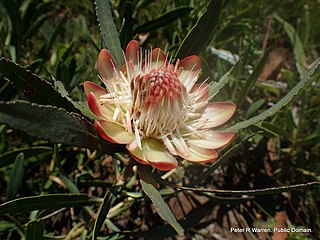
Protea simplex, the dwarf grassveld sugarbush, is a flower-bearing shrub belonging to the genus Protea. It is native to South Africa.
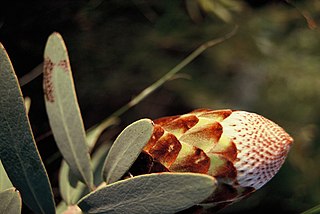
Protea inopina, the large-nut sugarbush, is a flowering shrub belonging to the well-known Protea genus. The plant is endemic to the Western Cape, rare, extremely isolated and occurs only in the Olifants River mountains near Palace Hill.
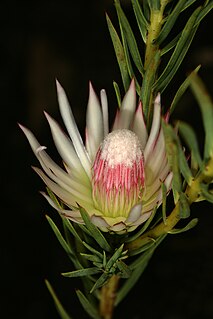
Protea mucronifolia, the dagger-leaf sugarbush, is a flower-bearing shrub belonging to the Protea genus. The plant is endemic to the Western Cape where it occurs from Hermon to Saron. This is the only population. The shrub grows upright and grows 1 m tall and flowers from October to January with the peak from November to December.

Protea humiflora, the patentleaf sugarbush, is a flower-bearing shrub belonging to the Protea genus. The plant is endemic to South Africa and occurs from the Du Toitskloof Mountains to the Langeberg and Waboomsberg. The plant grows to 2 m in diameter and flowers from July to September with its peak in August.

Protea aurea subsp. potbergensis, also known as the Potberg protea, or Potberg sugarbush, is a flowering plant of the genus Protea. It is endemic to South Africa and is found only in the Potberg near Cape Infanta. It grows to a height of 5 metres, and flowers primarily from May to June.

Protea subvestita, the waterlily sugarbush, is a flower bearing shrub that belongs to the well-known genus Protea. The plant is endemic to South Africa and occurs in Mpumalanga on the escarpment of the Wakkerstroom, Free State, KwaZulu-Natal, Lesotho, Eastern Cape and the Klein Swartberg. The shrub is large, erect and grows up to 5 m. It flowers mainly from January to March.
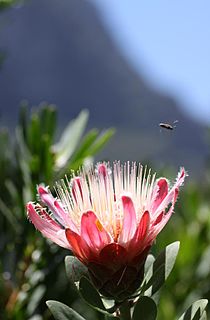
Protea venusta, the cascade sugarbush or creeping beauty, is a flower-bearing shrub belonging to the genus Protea. It is endemic to South Africa.
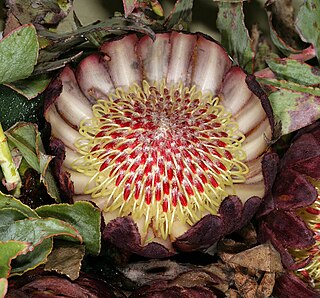
Protea amplexicaulis, the clasping-leaf sugarbush, is a flower-bearing shrub that belongs to the genus Protea. The plant is endemic to South Africa and occurs from Citrusdal to the Kogelberg, as well as in the Langeberg. The shrub remains low and spreads out, becoming 1.3 m in diameter and flowering from June to September.
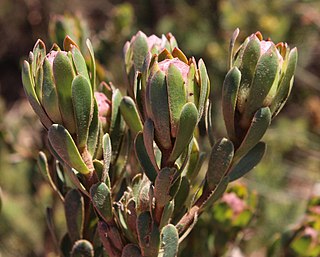
Leucadendron stelligerum, the Agulhas conebush, is a flower-bearing shrub that belongs to the genus Leucadendron and forms part of the fynbos. The plant is native to the Western Cape where it occurs from Elim to the Agulhas Plain.
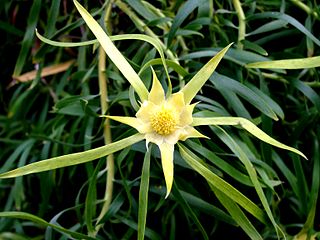
Leucadendron eucalyptifolium, the gum-leaved conebush, is a flower-bearing shrub belonging to the genus Leucadendron and forms part of the fynbos. The plant is native to the Western Cape and the Eastern Cape, where it occurs in the Potberg, Riversdal Plains, Langeberg, Outeniqua Mountains, Tsitsikamma Mountains, Kouga Mountains, Elandsberg, Swartberg, Waboomsberg, Warmwaterberg, Touwsberg, Rooiberg and Soetwaterberg. The shrub grows 4 m tall and bears flowers from July to October.

Leucadendron teretifolium, the needle-leaf conebush, is a flower-bearing shrub belonging to the genus Leucadendron and forms part of the fynbos. The plant is native to the Western Cape, South Africa.

Leucadendron spissifolium subsp. fragrans, the fragrant spear-leaf conebush, is a flower-bearing shrub belonging to the genus Leucadendron. The plant is native to the Western Cape and occurs in the Langeberg and Outeniqua Mountains from Gysmanshoek to the Woodville Forest Reserve, as well as the Swartberg and Kammanassie Mountains. It forms part of the fynbos.

Leucadendron spissifolium subsp. spissifolium, the common spear-leaf conebush, is a flower-bearing shrub belonging to the genus Leucadendron and forms part of the fynbos. The plant is native to the Western Cape where it occurs on the Gifberg and from the Cederberg to the Cape Peninsula and Kogelberg to Kampscheberg in the Langeberg.

Spatalla longifolia, the pink-stalked spoon, is a flower-bearing shrub that belongs to the genus Spatalla. It forms a part of the fynbos. The plant is native to the Western Cape where it is found in the Hottentots-Holland Mountains; from Franschhoek and Villiersdorp to the Kleinmond Mountains.
Spatalla tulbaghensis, the shaggy-hair spoon, is a flowering shrub belonging to the genus Spatalla and forms part of the fynbos. The plant is native to the Western Cape where it occurs on the Witzenberg Plains and Skurweberg Pass.
Aulax cancellata, the channel-leaf featherbush, is a shrub that is native to the Western Cape and the Eastern Cape and belongs to the genus Aulax. This plant is widespread, it occurs on the Cape Peninsula, Hottentots-Holland Mountains to the Langeberg and Kouga Mountains, Swartberg and Kammanassie Mountains. The shrub grows upright with a single stem and grows up to 2.5 m tall.
Spatalla nubicola, the Medusa spoon, is a flower-bearing shrub that belongs to the genus Spatalla and forms part of the fynbos. The plant is native to the Western Cape where it is found in the central Langeberg near the town of Heidelberg.
Spatalla colorata, the shiny spoon, is a flower-bearing shrub that belongs to the genus Spatalla and forms part of the fynbos. The plant is native to the Western Cape where it occurs from the Riviersonderend Mountains to central Langeberg.

















